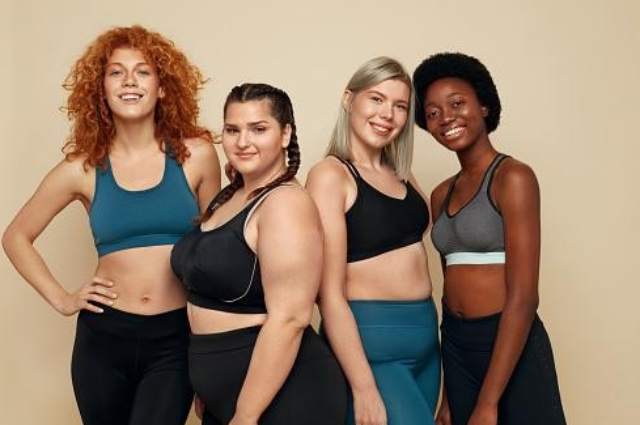
Imagine you wake up one day, look at the mirror, and shout aloud,
“Oh, My God! I have put on 5kgs, I am no more beautiful….”
What I want to know is, who told you, you were beautiful before? Who told you, you aren’t beautiful anymore? That’s the tag you gave yourself even before society did, and who as well gave society the right to measure anyone’s beauty or looks?
If nobody is perfect, how are the people making you feel ugly perfect or beautiful themselves?
Emma Watson once said, ‘Feeling beautiful has nothing to do with what you look like” isn’t it something we all need to follow more than just decoding it?
Kick-Start Of Body Positivity
Body Positivity was once such a movement which worked towards making society understand that body shaming, body skinning or any such disgraceful remarks given on someone’s body, especially women, was wrong and would not be tolerated.
It was started around 2012 and aimed at normalising female beauty standards with a motto, “ALL BODIES ARE BEAUTIFUL.”
Not only did it talk about physical looks, but it also contributed to making people accept mensuration, hormonal changes, and diseases associated with it to be a genuine concern and as normal as any other medical or health issue.
Body positivity initially grew under The Fat Acceptance Movement along with the National Association to Advance Fat Acceptance which aimed that all body types must be accepted and appreciated.
As per the point of feminism was concerned, body dissatisfaction was one thing that remained common in all three waves, and each wave had its battles to fight. Starting with fat women being forced to change themselves and being disrespected and subjugated due to their weight, size, skin colour, scars, patches, body hair, and health disorders, each wave witnessed women’s modesty being questioned.
How Brands Promoted Body Positivity
After 2014, a drastic positive change was seen as social media took over to spreading, body positivity at their end, which resulted in many youths and brands collaborating to celebrate each body structure and shape. Even the fashion world did allow and featured models of all kinds to make the situation normal. Each body feels normalised, e.g., Vogue did consider plus size dark women for their ramp walks and fashion magazine photoshoots.
A number of companies and Non-profit organisations joined hands to eliminate this mentality and help women and other genders grow further with pride and dignity. Dove, the popular brand, even initiated a specially held Dove Self-Esteem Project to help young people grow with equal self-esteem and confidence like so-called normal humans.

Image by myimagemybody.wordpress
To support this, even some clothing brands started selling plus-size clothes, namely, Vero Moda, Soncy, Pink Clove and Universal Standard, All, Shein, Mango, H&M, and ASOS, for both men and women.
Few Plus Size Brands To Swear By
Some of the famous brands involved in promoting women's empowerment with body positivity are:
- Nike
- Angrakhaa
- Ethicus
- Mustard
- Girlfriend Collective
- Alto Moda
- Lastinch
- Billie
- Sassy Soda
- Gia
- Asos
- Forever 21
- Loud Bodies
- Wray
Changes In The Fashion Choices Of People
The fashion segment has been a great and positive change; brands like Nike, Ethicus and Angrakhaa, and others have strongly supported women's empowerment and promoted the fact that fashion is not merely wearing bold clothes but the ease of being comfortable in your style and dressing.
All bodies are beautiful #normalizebodyfat.
- Nike’s first set of the launch of plus size clothing created a global impact as people started acknowledging-different body sizes and tones, and even women were confident about buying them.
- One more such brand, Girlfriend Collective, has a separate set of collections for plus sizes like 2XL to 6XL and along with it, it also offers small and medium size ranges to shelter all body sizes under one roof.
- Angrakhaa, featured in Shark Tank India Season 2 in 2023, was another hit brand that women entrepreneurs lead. They provide all size clothes under one website with a strong statement of serving all women their desired clothing, whether dresses, skirts, gowns or a simple off-shoulder piece top.
- Billie’s brand took the movement ahead when it launched a new section of razors for women. It openly depicted in advertisements how women can use razors for their body hair, normalised the concept of shaving for women, and made a great sales pitch.
- Ethicus is setting one of the best examples by casting normal ordinary, or not-so-popular common men and women in their shooting, passing on the message that their brand is open to every individual and class of society. This is a great marketing strategy and helps consumers to engage with the brand. They hire people of different sizes, skin tones, castes and sectors to prove their mission to reach out to every person in the world.
Body Positivity vs Body Neutrality
Body Neutrality is another concept which is different from Body positivity. It promotes the fact that skin and body is a natural phenomenon, and it is very natural for people to feel insecure about it at times, and it is a human instinct. It may have a positive or negative impact on people. Still, one cannot completely be ignorant of their body as there is a high risk of health involved with malnutrition, body diseases and being overweight like diabetes, heart attack, high blood pressure, cholestrol and so on.
Body neutrality is based on the opinion that it's not just about appearance and looks; people sometimes need to adjust to their body types and change or improve them to maintain a healthy lifestyle. For example, it is important to exercise and ensure fats do not get stored in their body for people more than the average weight as it promotes diseases. Body Neutrality believes that body and core values must be addressed and accepted with dignity.
How Social Media Takes Off The Game
Social Media has taken body shaming and body positivity to a peak. Like a coin with two sides, social media has positives and negatives on one side, where it has openly spread positivity and encouraged women to be as natural and real. The other side focuses on how social media trolls' constant filters to enhance the pictures and hide reality make people more conscious.
Many fashion influencers have come forward to make people aware and be style statements for others, and help them be comfortable in their own skin and size. Lu D’Souza, Dolly Singh, Alok, Sakshi Sandwani, and Neha Parulkar are great examples of such influencers. Fizah Khan, a celebrity, even promoted the same in a popular MTV show, Ace Of Space, and many people appreciated the same.
A new trend has started, i.e. ‘Instagram vs Reality’, which closely highlights the issue of body trolling and shaming faced by men equally and breaks the gender constraints. As per research, more than 1000+ posts have been associated with spreading positive messages but have turned into controversies due to hate comments and feedback made by people with different opinions and experiences across the globe. This has forced people to filter their posts while uploading them ti hide the reality under social media groups.
Due to the increase in the involvement of people and their constant reactions, along with women, even men in today’s scenario, go through the issues of body shaming, trolling and absurd comments made by both men and women. The researchers even conclude that these are potentially more harmful to men’s body image and have started to create an absolutely new category where men even get a social stigma of appearance.

Summary
Body Positivity has also promoted the LGBTQIA+ community and women with disorders, down syndrome, and plus size; it has made people aware of various conditions prevailing and how it's all in the perception, and nothing can be a restriction to people’s happiness.
Although the fight isn’t over yet, a lot has changed, and we believe a lot will change for people would make it happen because all bodies are good bodies, and everything is beautiful if you have the art of acceptance. With this, people also need to accept the fact that body size is not the issue, but an unhealthy lifestyle associated with it can be one!
. . .
Resources:
